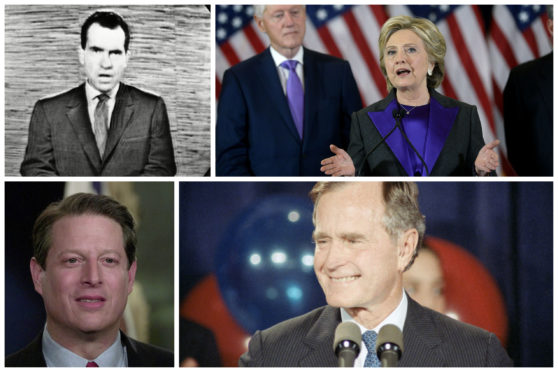With the final votes being tallied across the United States, it is looking more and likely that Donald Trump has lost this election.
Regardless of how bitterly and close-fought elections have been in recent years, the defeated candidate has always come out and given a speech – with similar themes of humility and working together as a nation.
Mr Trump, however, is refusing to accept the result of the election, flinging claims of fraud and voter interference across social media and calling for the counts to stop.
This is all despite offering no evidence for any of his claims, and with social media sites and US television networks shutting down his unsubstantiated accusations.
Given his current position, and the number of legal actions already in motion, it’s looking very unlikely he will be making any concessionary speeches.
How important are concession speeches?
According to William Howell, chairman of political science at the University of Chicago, not giving one would be “truly harmful.”
Speaking to USA Today, he said: “Concession speeches are a kind of affirmation about the legitimacy of elections.”
Adding it shows they recognise the outcome, and ask their followers to do the same “which is essential for the health of our democracy”.
Here we look at some of the most famous speeches given by the losing candidate over the last 30 years.
Hillary Clinton 2016
Despite winning the popular vote in 2016, garnering almost 2.9 million more votes than Donald Trump, Hillary Clinton was only able to secure 227 of the needed 270 electoral college votes.
Speaking the day after the election, she told a crowd in New York how she had “congratulated Donald Trump and offered to work with him on behalf of our country” adding she hoped ” he will be a successful president for all Americans”.
In her speech, she described the pain of the loss, but reminded her supporters that “fighting for what’s right is worth it”.
She ended her address by saying: “I am incredibly honoured and grateful to have had this chance to represent all of you in this consequential election. May God bless you and may God bless the United States of America.”
Richard Nixon 1960
Nixon’s speech in 1960 was the first to be televised and followed his narrow loss to JFK.
In it, he congratulated “Senator Kennedy for his fine race in this campaign”.
Republican Nixon lost the public vote by just 112,000, but was 84 electoral votes behind his Rival.
He went on to win the election in eight years later, beating Democrat Hubert Humphrey.
Gerald Ford – 1976
Due to a bout of laryngitis, then-President Gerald Ford was unable to deliver his only concession speech after losing to Jimmy Carter.
Instead, his wife Betty spoke to gathered supporters and reporters to say Ford had spoken president-elect Carter to congratulate him, saying “The president asked me to tell you that he telephoned president-elect Carter a short time ago and congratulated him on his victory.”
George H.W. Bush – 1992
In 1992 Democratic candidate Bill Clinton swept aside President George H.W. Bush to win both the public and electoral votes by a significant margin. What followed is a great example of a concession speech which puts country first.
He told supporters his team would work with the Mr Clinton to ensure a smooth transition of power, and that “there is important work to be done and America must always come first”.
Al Gore – 2000
The election in 2000 is the most contentious in recent memory – with the exception of this year’s, perhaps.
Vice President Al Gore won the public vote, beating George Bush by a little over 500,000 votes. However, the electoral result was much closer, with Gore only securing 266 votes.
During the Florida count, Mr Gore actually conceded the election privately to Mr Bush, only to later withdraw this after the number of votes between the two continued to drop.
In the end, Mr Bush’s margin of victory in Florida was so close, a recount and a Supreme Court ruling was required to settle the results.
In his speech, Mr Gore told how he had spoken with Mr Bush and congratulated him on his victory and promised he “wouldn’t call him back this time”.
He told how he had offered to meet the president-elect to “start to heal the divisions of the campaign and the contest”, continuing on to say “may God bless his stewardship of this country”.
Kanye West – 2020
The hip-hop star didn’t even receive 0.5% of this year’s vote. In the early hours of Wednesday he simply tweeted an image of the electoral map, alongside the word “Welp”.
This has since been deleted, with a new tweet suggesting he will be running again in 2024.
KANYE 2024 pic.twitter.com/Zm2pKcn12t
— ye (@kanyewest) November 4, 2020
